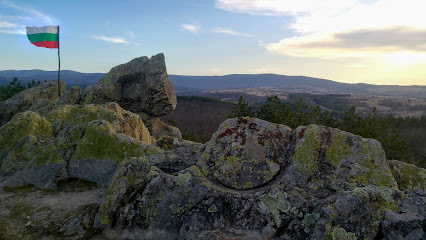Rock sanctuary of the sun Paleokastro
Overview
Paleokastro archeological site is located on the northern slopes of Sakar Mountain between the town of Topolovgrad and the village of Hlyabovo, about 3 km west of the town.
The site is considered a rock sanctuary dedicated to the Sun, and this is a working hypothesis. Its cult character has not been conclusively proven.
The site, considered by archaeologists as a sanctuary, is named after the ancient Thracian fortress of Paleokastro. In the fortress itself rise high rocks, which form on their tops a chain of ridges, facing with one long side to the east. Therefore, the entire eastern length of the rocky chain is exposed in the morning to the rays of the rising sun. More than 150 disks modeled in the rocks on the ridge have been made on all surfaces of this country (the so-called "solar disks" have been repeatedly published in scientific works dedicated to megalithic monuments, often interpreted as Thracian. Their number ranges from 140 to over 200 with circles with a diameter of 25 to 100 cm, some of the discs are convex and protrude above the surface of the rock by 3 - 5 cm, others are concave to approximately the same size in depth. marked in holes in the rock.In places they are grouped in two or three, arranged horizontally and vertically. The "suns" are carved in both high and low relief. 0.20 cm to 1 m. All discs carved into the rock are illuminated by the morning sun.
It is interesting to note that wherever the stone disks are carved (all over the back of the top) there are disks, the upper part of which protrudes above the earth's surface, while the lower part remains in the ground. This is evidence for archaeologists that they were dug in very ancient times and were buried by natural soil uplift, as an embankment or sediment on this peak would be difficult to form on this peak.
At the highest point of the ridge, the rocks form a protective strip, which was used to build a fortress in the early first millennium BC. The fortress has been rebuilt many times and functioned during the Middle Ages. From it comes the name "Paleokastro" (Παλαιόκαστρο) (from the Greek "Παλαιόσ - Palaios" - old, ancient, former and "καστρο - kastro (n)" - fortress), which is named after the sanctuary.
The performed measurements of the slope and the direction of occurrence of the better expressed circles in the metamorphic rock with a geological compass show that the rocks lie steeply at an angle of 41 - 57 ° (average 48 °) and north-northeast (NNE) direction 13 - 30 ° (average 25 °). The measured slope and direction coincide with the crystallization schistosity of the rocks. It was the decisive factor in the detachment of the stone circles carved to a certain depth. Therefore, according to the Bulgarian geologist Prof. Dr. Ruslan I. Kostov, the existing idea in the scientific literature of an east-facing sanctuary and a solar cult with stone "suns" should be abandoned. In general, "rock circles" are marked in negative and positive with large and small diameters. The measured diameter of the large circles varies between 79 - 102 cm (average 88 cm), and for the small circles - 25 - 46 cm. The thickness of the carving of a separate rock circle reaches 10-15 cm. From a geometric point of view, the object carved out of the rock would have the shape of a short (flat) cylinder.
Location
The sanctuary is 2.5 km southwest of the town of Topolovgrad. Peak Paleokastro (424 m) rises above the whole area and has good visibility from a long distance.
Recommended
- Megalith Paleokastro Sun Sanctuary
- Dolmens in Hlyabovo
- Ustrem Monastery
- The area and the cave "Dranchi Dupka" about 3 km south of the village of Sakartsi among an oak forest and others


 Bulgarian
Bulgarian Romanian
Romanian
